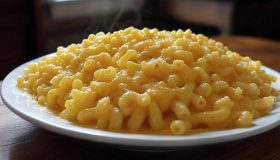Macaroni and cheese, the quintessential comfort food, holds a cherished place in the hearts of food lovers worldwide. Its creamy, savory richness provides both indulgence and nostalgia, transcending cultural and geographical boundaries. Yet, this beloved dish has a fascinating and complex history, stretching from the culinary traditions of medieval Europe to its iconic status in modern global cuisine. The journey of macaroni and cheese is as rich and varied as the dish itself, reflecting societal changes, technological advancements, and evolving tastes over centuries.
Medieval Origins: A Royal Delight
The origins of macaroni and cheese can be traced back to 14th-century Europe, where early recipes of pasta and cheese combinations first appeared in culinary manuscripts. These early iterations of the dish were a far cry from today’s creamy, boxed versions but laid the foundation for its evolution.
1. De Lasanis: The Italian Roots
The Italian manuscript Liber de Coquina (circa 1300) contains one of the earliest known recipes resembling macaroni and cheese. Called de lasanis, this dish featured layers of hand-crafted pasta interspersed with grated cheese and butter. The simplicity of ingredients belied the effort required to produce pasta by hand, making the dish a luxury item reserved for the wealthy.
2. The Forme of Cury: England’s Contribution
Across the English Channel, a similar recipe appeared in The Forme of Cury, a royal cookbook compiled during the reign of King Richard II in the late 14th century. The English version, known as “makerouns,” also combined pasta, butter, and cheese, reflecting the culinary connections between Italy and England.
Why Pasta and Cheese?
During this period, cheese was a staple protein source, while pasta provided a long-lasting, versatile carbohydrate. The pairing of these two ingredients was both practical and indulgent, allowing cooks to create a rich, satisfying dish that could be adapted to different occasions.
A Revolutionary Journey to America
Thomas Jefferson: The Patron of Macaroni
The modern popularity of macaroni and cheese in America owes much to Thomas Jefferson, the third President of the United States. While serving as the U.S. ambassador to France, Jefferson encountered refined European cuisine and developed a particular fondness for pasta and cheese dishes. Enthralled by its elegance, he returned to the U.S. with a pasta-making machine and began serving macaroni and cheese at Monticello, his Virginia estate.
In 1802, Jefferson introduced macaroni and cheese to a broader audience by serving it at a state dinner. His endorsement sparked interest among American colonists, who began adapting the dish to their own tastes and available ingredients.
Cultural Adaptation in the U.S.
As macaroni and cheese spread across the country, it transitioned from a luxury item to an everyday dish. Cooks replaced expensive imported cheeses with local varieties, and baked casseroles became a popular preparation method. By the 19th century, macaroni and cheese had firmly established itself as a staple of American cuisine.
The 20th Century: Reinvention and Mass Appeal
The Kraft Revolution
The year 1937 marked a turning point in the history of macaroni and cheese with the launch of Kraft Macaroni & Cheese Dinner. This innovation transformed the dish into an affordable, convenient meal for millions:
- Shelf-Stable Convenience: The boxed dinner included dried pasta and powdered cheese, eliminating the need for fresh ingredients.
- World War II Popularity: During the war, rationing of fresh dairy and meat made Kraft’s product a go-to option for families seeking a filling, economical meal.
By the mid-20th century, Kraft’s version had become a household staple, cementing macaroni and cheese’s reputation as the ultimate comfort food.
Baked vs. Stovetop
While Kraft popularized stovetop macaroni and cheese, baked versions remained a favorite in home kitchens and restaurants. These richer, heartier renditions featured layers of pasta, cheese sauce, and crispy breadcrumbs, offering a contrast in texture and flavor.
Macaroni and Cheese Goes Global
1. Caribbean Variations
In the Caribbean, macaroni pie is a beloved side dish, often spiced with Scotch bonnet peppers and flavored with herbs. It’s a staple at family gatherings and festive occasions, offering a spicier twist on the classic.
2. Italy’s Pasta Al Forno
While not identical to macaroni and cheese, Italian pasta al forno (baked pasta) bears similarities, with layers of pasta, béchamel sauce, and grated cheese baked to golden perfection.
3. Modern Fusion
Chefs worldwide have elevated macaroni and cheese with innovative ingredients:
- Gourmet Cheeses: Incorporating Gruyère, fontina, or truffle-infused varieties.
- Seafood Additions: Lobster mac and cheese has become a luxurious indulgence in high-end restaurants.
- Plant-Based Versions: Vegan adaptations use cashew-based cheeses and nutritional yeast, making the dish accessible to plant-based eaters.
Cultural Significance: Why We Love Macaroni and Cheese
1. Comfort and Nostalgia
Macaroni and cheese evokes a sense of warmth and familiarity, often tied to childhood memories. Its creamy texture and savory flavor offer emotional solace, making it a go-to meal during tough times.
2. Versatility
From casual family dinners to gourmet interpretations, macaroni and cheese adapts effortlessly to any occasion. Its simplicity allows for endless customization, whether through the addition of meats, vegetables, or spices.
3. Iconic Status
In America, macaroni and cheese is more than just food—it’s a cultural symbol. It has appeared in pop culture, cookbooks, and even as part of Thanksgiving feasts, reflecting its universal appeal.
Health and Modern Adaptations
As dietary preferences evolve, so too has macaroni and cheese:
- Whole-Grain Pasta: Increasing fiber content for health-conscious eaters.
- Dairy-Free Alternatives: Cashew-based or plant-derived cheeses cater to lactose-intolerant individuals.
- Veggie-Loaded Versions: Broccoli, spinach, and cauliflower mac and cheese offer a nutritional boost.
Conclusion: A Culinary Icon That Endures
The journey of macaroni and cheese from medieval Europe to the global stage is a testament to its timeless appeal. Its ability to adapt to new ingredients, cultures, and tastes has ensured its enduring popularity. Whether served as a quick stovetop meal or a lavish baked casserole, macaroni and cheese continues to bring comfort and joy to millions, celebrating a rich history as diverse as its flavors.
As food trends come and go, macaroni and cheese stands firm—a delicious reminder of the power of simplicity, tradition, and innovation in the world of cuisine.




